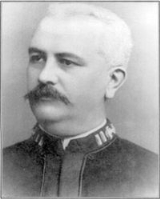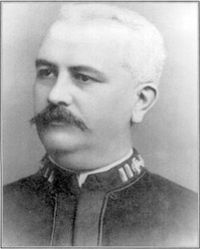
Theodorus B. M. Mason
Encyclopedia

Office of Naval Intelligence
The Office of Naval Intelligence was established in the United States Navy in 1882. ONI was established to "seek out and report" on the advancements in other nations' navies. Its headquarters are at the National Maritime Intelligence Center in Suitland, Maryland...
, with the post of Chief Intelligence Officer (prior to it being redesignated as Director of Naval Intelligence
Director of Naval Intelligence
The Director of Naval Intelligence refers to either one of two posts, both related to naval intelligence:* The head of the Naval Intelligence Division of the British Admiralty; or* The head of the Office of Naval Intelligence in the United States....
in 1911).
Mason came from a distinguished New York family. He was the son of Theodorus Bailey Myers, who was a lawyer and served as a colonel
Colonel
Colonel , abbreviated Col or COL, is a military rank of a senior commissioned officer. It or a corresponding rank exists in most armies and in many air forces; the naval equivalent rank is generally "Captain". It is also used in some police forces and other paramilitary rank structures...
in the United States Army
United States Army
The United States Army is the main branch of the United States Armed Forces responsible for land-based military operations. It is the largest and oldest established branch of the U.S. military, and is one of seven U.S. uniformed services...
during the Civil War; his uncle, Rear Adm. Theodorus Bailey
Theodorus Bailey (naval officer)
Theodorus Bailey was a United States Navy officer during the American Civil War.-Early career:Bailey was born at Chateaugay, New York in the far north-eastern corner of Franklin County, near the border with Quebec. He received his early education at Plattsburgh, before being appointed a midshipman...
, served under Admiral David Farragut
David Farragut
David Glasgow Farragut was a flag officer of the United States Navy during the American Civil War. He was the first rear admiral, vice admiral, and admiral in the United States Navy. He is remembered in popular culture for his order at the Battle of Mobile Bay, usually paraphrased: "Damn the...
in New Orleans. He was given the last name Mason in deference to his maternal grandfather, who had no male heirs to carry on the family name.
A graduate of the United States Naval Academy
United States Naval Academy
The United States Naval Academy is a four-year coeducational federal service academy located in Annapolis, Maryland, United States...
in 1868, Mason was a distinguished linguist with an inquisitive mind, qualities that gave him respect and recognition in the Navy. After a stint in the Hydrographic Office
Hydrographic office
A hydrographic office is an organization which is devoted to acquiring and publishing hydrographic information.Historically, the main tasks of hydrographic offices were the conduction of hydrographic surveys and the publication of nautical charts...
, he travelled extensively in Europe
Europe
Europe is, by convention, one of the world's seven continents. Comprising the westernmost peninsula of Eurasia, Europe is generally 'divided' from Asia to its east by the watershed divides of the Ural and Caucasus Mountains, the Ural River, the Caspian and Black Seas, and the waterways connecting...
and South America
South America
South America is a continent situated in the Western Hemisphere, mostly in the Southern Hemisphere, with a relatively small portion in the Northern Hemisphere. The continent is also considered a subcontinent of the Americas. It is bordered on the west by the Pacific Ocean and on the north and east...
as a naval observer collecting ideas on naval intelligence systems; he knew what information was available and how to obtain it. He recognized that in order for the Navy to compete with its European counterparts, research in naval science and technology should be encouraged; as part of this objective, a unified intelligence agency was needed to gather information on foreign developments for proper dissemination and coordination with the different Bureaus. He made these recommendations upon the request of Secretary of the Navy William H. Hunt
William H. Hunt
William Henry Hunt was the United States Secretary of the Navy under President James Garfield and briefly under President Chester A. Arthur.-Biography:...
.
Hunt read and agreed with most of Lt. Mason's recommendations, and consequently issued General Order No. 292 on March 23, 1882, establishing the Office of Naval Intelligence as part of the Bureau of Navigation
Bureau of Navigation
The Bureau of Navigation was an agency of the U.S. government established in 1884 to enforce laws relating to the construction, equipment, operation, inspection, safety, and documentation of merchant vessels. The Bureau of Navigation was an agency of the U.S. government established in 1884 to...
, with Mason himself as its first "Chief Intelligence Officer". He assumed this post on June 1882. The Office was initially assigned to a small office in the State, War and Navy Building (now the Old Executive Office Building
Old Executive Office Building
The Eisenhower Executive Office Building , formerly known as the Old Executive Office Building and as the State, War, and Navy Building, is an office building in Washington, D.C., just west of the White House...
).
Despite initial difficulties, the different Bureaus recognized its value and used it to share information amongst themselves and used this information in justifying funds needed for Navy expansion and modernization.
Mason clearly guided the ONI well during its first years, and was succeeded by Lt. Raymond P. Rodgers
Raymond P. Rodgers
Rear Admiral Raymond Perry Rodgers was an officer in the United States Navy. He succeeded Lt. Theodorus B.M. Mason as the second head of the Office of Naval Intelligence....
in April 1885. He retired from the Navy in 1894 as a lieutenant commander
Lieutenant Commander
Lieutenant Commander is a commissioned officer rank in many navies. The rank is superior to a lieutenant and subordinate to a commander...
and died five years later. He is interred in Green-Wood Cemetery
Green-Wood Cemetery
Green-Wood Cemetery was founded in 1838 as a rural cemetery in Brooklyn, Kings County , New York. It was granted National Historic Landmark status in 2006 by the U.S. Department of the Interior.-History:...
in Brooklyn, NY.
Mason wrote one such account in which he described the belligerents of the Atacama border dispute
Atacama border dispute
The Atacama border dispute was a dispute between Chile and Bolivia in the 19th century that ended in the transfer to Chile of all of the Bolivian Coast and the southern tip of Bolivia's ally Peru through the Treaty of Ancón with Peru and the Treaty of Peace and Friendship of 1904 between Chile and...
. As stated above, he was resourceful and reports that the material used for the paper was derived from personal observation, from apparently authentic publications, and from other Naval officers within the region at the time of the conflict. Mason's work is a chronology of events leading up to, during, and the outcome of the War of the Pacific
War of the Pacific
The War of the Pacific took place in western South America from 1879 through 1883. Chile fought against Bolivia and Peru. Despite cooperation among the three nations in the war against Spain, disputes soon arose over the mineral-rich Peruvian provinces of Tarapaca, Tacna, and Arica, and the...
.

